Before the J Class yachts came into existence, yachts were designed to be bigger and bigger. The towering rigs of the Big Boat Class such as ‘ Lulworth ’ and ‘ Britannia ’ dwarfed all other yachts. The late 1920s heralded discussion and agreement of the Universal Rule. This new formula controlled the size and displacement of the new yachts, enabling them to be raced as evenly as possible. Almost immediately, designs were being commissioned for the new, massive ‘Bermudan rigs, with no bowsprits’.
The rule was based on ideas proposed by Nat Herreshoff allowing waterline length to be increased without sail area being restricted, as it had been under the International Rule. This was compensated by a larger displacement and so draught was limited to 15ft.
In 1929 Sir Thomas Lipton, owner of Lipton’s famous for his import of Lipton Tea from India, issued his fifth challenge to the Americans for the America’s Cup. He commissioned the build of the first J Class Yacht which signified the start of a new era in design evolution and racing. On each occasion he challenged for the America’s Cup as a member of the Royal Ulster Yacht Club in Northern Ireland. RUYC are still involved with The Cup – presenting the Royal Ulster Cup to the Club of the winning challenger.
The Universal Rule came into effect in 1930. The size of a yacht was determined (by waterline length) and this was shown as an alphabetical list. “J” signified yachts with a waterline length of between 75 to 87 feet. The addition of the new design Bermuda mast allowed the yachts to carry a huge sail plan. Nothing so large and ‘awesome’ had been built previously. The Americans had a distinct advantage over Britain in the 1930 America’s Cup. They had the money to build four J’s over Britain’s one, yet the British yacht, Shamrock V was a hot contender. She was designed by Nicholson and built at the family yard in 1930, and before she crossed the Atlantic to attend the Cup she had notched up more than 700 sea miles (1,296km), won 15 out of the 22 races she had entered and had been tweaked and tested to a high degree.
In answer to Lipton’s challenge of 1929 the Americans designed four J-Class yachts as possible defenders. Enterprise, Whirlwind, Yankee and Weetamoe were launched within a month of each other; Weetamoe and Enterprise from the Herreshoff yard and Yankee and Whirlwind from Lawley & Son’s yard in Bristol.
Whirlwind, the second J, was the most revolutionary of the four. Francis L Herreshoff had moved away from conventional yachts and designed a boat, which took the new rule to its extreme. Whirlwind combined many new ideas and Herreshoff experimented with hull shape and rig. She was the longest of the early J’s at 86ft on the waterline and remained so until Ranger and Endeavour II were built in 1937.

She was built of semi-composite construction (the other three American Js were built out of the highly expensive Tobin bronze), was double-ended and had a permanent backstay. Uffa Fox described her profile as: “Very pleasing to the eye, the stem sweeping down to the keel in a very sweet line, and to a man who, like myself, believes that a pointed stern is a logical ending for all vessels, her stern is a joy to behold.” He predicted, “If the Yacht Racing Rules govern well and wisely, we shall see Whirlwind racing 50 years hence. If they do not she will probably be cruising then.” But Whirlwind met an early demise. Her building was delayed as she didn’t meet Lloyd’s A1 scantling rules and she wasn’t chosen to be the 1930s defender. She was often out-performed when close hauled, her steering gear making her difficult to steer. She was eventually scrapped along with Enterprise in 1935. However, her unusual double-headsail rig was later adopted by the rest of the Js.
The third American J, Yankee, was the best all-rounder. At 84ft on the waterline and 125ft length overall, she was solidly made of Tobin bronze and was extremely well balanced. Designed by Frank Paine , Yankee had an almost straight sheerline and easy lines. She was a powerful contender for defender, but not fine-tuned enough to succeed. She did, however, take part in the 1934 America’s Cup trials and with alterations to her rig, to carry more sail, and bow, which was lengthened and made more of a V-shape, she then proved more successful, especially in light winds.
The fourth of the American J’s was Weetamoe, which was designed by Clinton Crane and was the narrowest of the early four. Despite claims that Yankee was the best all-rounder, Weetamoe is said to have been the closest rival to Enterprise to be the Cup defender. Charles Nedwick, in Ian Dear’s book Enterprise to Endeavour, describes Weetamoe as having a profile “that is practically a triangle, with a straight line from the after end of the waterline to the bottom of the keel and thence a line which is slightly convex, and then slightly concave to the forward end of the waterline.” In an attempt to better performance and make her less tender, her profile below the water was radically altered in 1934 with a new contour and bulb keel. The alterations failed and not long afterwards were reversed. In common with the other J’s, she had about 43ft of overhang and her hull, Nicholson opined, “was the best of all the US Js”.
When Shamrock V and Enterprise eventually met off Newport, Rhode Island, later that year, the two J’s were well matched in hull profile, but differed significantly in rig. Enterprise’s rigging was lighter, she had the Park Avenue boom, which was so advantageous to windward, and had lots of winches on board. Shamrock V meanwhile, was under-winched and hard work to sail. She has since, however, proved her success in that she is still sailing today.
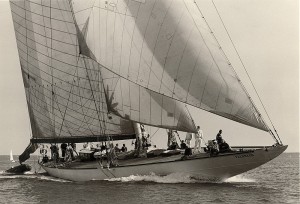
The sixth J-Class yacht to be built, and the second built on British soil was Velsheda . She was the only J not built as a contender for the America’s Cup. Her owner, WL Stephenson, who previously owned White Heather II, the 23-Metre converted to rate as a J-Class in 1930, had Velsheda built in steel in 1933 at the Camper & Nicholson yard. Velsheda was a great success. In 1935 she was significantly altered, her bow was snubbed around the waterline and her stern improved. The following season she won the King’s Cup at Cowes Week.
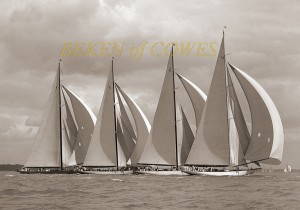
In 1934, Sopwith challenged for the America’s Cup. His challenger was Endeavour . She was Charles Nicholson’s third J-Class design and he said of her “She will have quite a normal hull… because I have thought it right to suppress possible experimental form, which would be most interesting to try out, but which I have to leave to American designers.” He did, however, produce the most beautiful J-Class and her rig was innovative.
Sopwith experimented with new running backstay strain gauges, which controlled the trim of the mast and used electronic windspeed and direction indicators. It has since been suggested that part of the reason for her failure in the Cup was due to all the gadgets on board. She was matched 83ft 3in on the waterline against Rainbow ’s 82ft. However, despite being thought to be the best challenger Britain has ever built, she did not win the Cup. Rainbow, which was considered the inferior boat, beat her by four races to two.

Rainbow was designed by W Starling Burgess and launched in 1934 from the Herreshoff yard where she was built in just 100 days. The J stepped a pear-shaped duralumin mast, designed to take the strain of the double-headed jib – first used on Whirlwind – and she was originally rigged with a Park Avenue boom. This was later removed because it was considered too heavy.
The UK Class was depressed with the death of King George V and scuttling of his yacht “Britannia” off the South of the Isle of Wight, in accordance with his will.
Of the American Js, Yankee was the only one to sail in British waters when she was bought by Gerald Lambert and crossed the Atlantic in 1935. She was scrapped in 1941. Enterprise and Whirlwind were both scrapped in America.
1937 saw the building of the last two J’s on both sides of the Atlantic. Both Ranger and Endeavour II took the waterline length to its extreme, measuring 87ft LWL . Ranger, the American boat, was built at Bath Ironworks in Maine and designed jointly by W Starling Burgess and Olin Stephens . It was a design combination, which produced the greatest J of the fleet – the ‘super J’ as she was later known. She was built, for the cost of the materials only, of flush riveted steel plating and soon after launching had an accident. The upper parts of her rod rigging which stayed her duralumin mast shook loose and her mast snapped “with a report like a cannon”.
Ranger’s success on the water was widespread. Of 37 starts she won 35. Owner-skipper Harold Vanderbilt described her as being “slower to turn and to pick up speed, but (she) held her way longer, and was perfectly balanced on the wind.” The challenger, Endeavour II, was designed by Nicholson again and built at the C&N yard. She too was steel, but flush-plated above and below the waterline. Sopwith towed her and Endeavour, plus an entourage of 100, to America where he worked on tuning her rig. Sadly, Ranger saw off the competition, easily winning four races, and dashing British hopes.
Although they became recognised the most beautiful yacht design in the world, only 10 J Class yachts were ever built – 6 in the USA and 4 in the UK. Most of these competed in trials for the America’s Cup, or competed in the Cup itself. Several existing large British yachts, ‘ Astra ’, ‘ Candida ’, ‘White Heather II’ and ‘Britannia’, the King’s yacht, were all converted to comply with the rule and raced alongside the J’s.
After the victory of Ranger over Endeavour II, Vanderbilt wondered whether the boat was so much faster than the competition that it might kill the class. History would show this was not the case as analysis of the Holm design shows that it would likely have been faster than Ranger.
1937 marked the end of an era – it was the last America’s Cup contest for 21 years and marked the end of Big Yacht racing. Shamrock V was sold to Mario Crespi, the Italian Senator and publisher, who converted her to a ketch rig and renamed her ‘Quadrifoglio’, with a literal translation giving her authentic name of ‘4 leaves’ in Italian. This was in accordance with an Italian law, which forbade foreign names.
Weetamoe was scrapped in this year, while at the end of the season Ranger was laid up, prior to being scrapped in 1941.
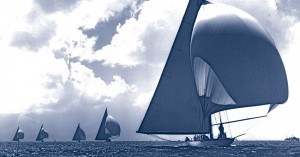

HANDLING THE J CLASS YACHTS IN THE 1930’s
The Skippers had to be experienced in racing and their skill on the race circuit became a matter of pride. These mighty craft had no engines and they had to be handled with great precision to get into and out of ports. Often their experience came from sailing all types of small craft, including fishing boats, during the winter months, when the J Class yachts were laid up. The permanent racing crew in the early days was probably around 16 men thou this may have been augmented to around 30 for racing. When not required for sail changes, spare crew were often moved to below decks.
With the incredible loads on the rigging and systems it was a constant concern that J Class masts could collapse in winds above a Force 3.
Sailing small boats in often inhospitable waters gave them the skills to manage their J Class yachts. The same is true today. Skippers have to deliver their yachts across Oceans, and compete around the race course, using their skills and all the technical advantages that are available today.
It is now clear that there was another J Class Yacht under development in 1937. Several years ago, drawings for a J-Class boat by Swedish naval architect Tore Holm were discovered by Fred Meyer, (Société Nautique de Genève – the Defender of the 32nd America’s Cup).
Now known as the Holm Project, this was to be a Swedish yacht with an innovative design. Many of the hull plates were made – and exist to this day. The project was put on hold prior to the outbreak of War in 1939 and was forgotten for more than 60 years. Endeavour and Endeavour II (K6) were laid up at Camper & Nicholson’s yard in Gosport, England.
Rainbow was scrapped. By the end of 1941, all the US yachts, which had been laid up were scrapped for their metal, with the last two being Yankee and Ranger. None survived. Yankee’s owner Gerard Lambert allegedly donated her scrap money from the yacht to Queen Mary to be used at her discretion in the London Hospital, in memory of the courtesies shown to Yankee by King George and the Queen herself.
Endeavour II was sold for scrap to Charles Kerridge Limited but her hulk remained until the late 1960s. Endeavour and Velsheda became houseboats in a mud berth on the River Hamble. This is where they stayed for more than 30 years, protected by the mud, which they had sunk into. Only Shamrock V was still sailing.
Endeavour II was broken up and scrapped in Southampton. Quadrifoglio (Shamrock V) had been hidden in Italy in a barn throughout the war years and following Crespi’s death in 1962 was sold to Piero Scanu, who saved her just two weeks before she was due to be broken up in Genoa.
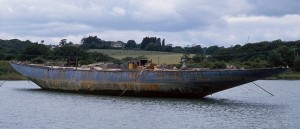
During the 1970s Endeavour’s hulk was sold for £10 and restoration was started.
Quadrifoglio (Shamrock V) arrived from Italy and was refitted at Camper & Nicholson’s yard where she had been built, supervised by Paolo Scanu the naval architect, and son of the owner.
The large holes in Endeavour’s hull were plugged and she was towed to the old seaplane base at Calshot Spit on the Solent to start restoration.
Terry Brabant rescued Velsheda from her Hamble mud berth and gave her enough of a refit to get her chartering and, occasionally, racing again in events like the annual Round the Island Race, hosted by the Island Sailing Club in Cowes. Despite being in rather poor condition she still acquitted herself well and looked magnificent from a distance. Swiss plans to restore her came to nought and the old racing yacht was eventually laid up afloat in Gosport. Elizabeth Meyer took on the challenge to continue with the rebuild of Endeavour at Calshot.
Quadrifoglio (Shamrock V) was purchased in 1986 by the Thomas Lipton Company, and given back her original name of Shamrock V, when she became the property of the Newport Museum of Yachting. Endeavour was towed from Calshot, to Cowes on the Isle of Wight to have her fittings and rigging fitted. She was then taken on a barge to the Royal Huisman Shipyard in Holland to continue and complete the rebuild.
Endeavour was relaunched in Holland. Endeavour and Shamrock V match raced each other over the Old America’s Cup course in Newport, Rhode Island in August.
Velsheda was purchased from a bankrupt C&N boatyard and brought to Southampton Yacht Services to start her rebuild. She was relaunched in 1998 and started her programme of racing and cruising around the World.
Velsheda, Shamrock V and Endeavour raced against each other in Antigua Classic Week.
The Owners met in England and formed the J Class Association to protect the interests of the Class, present and future. Class Rules were established for the construction of Replica Rebuilds from original plans. Shamrock V came out of a major refit at Pendennis in Falmouth under the supervision of the Dykstra office.

The first J Class Regatta is held in Christchurch Bay on England’s south coast over three days, followed by the Jubilee Regatta in Cowes.
Ranger replica was commissioned and construction started at Danish Yacht Shipyard.
Ranger was launched and started her racing programme.
Replicas of Endeavour II (Hanuman) and Ranger (Lionheart) are commissioned.
Replicas of Rainbow and Paine design (JH7) are commissioned.
Hanuman, replica of Endeavor II launched.
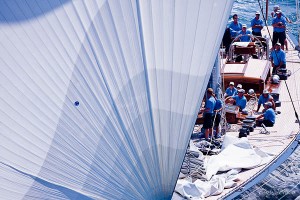
Lionheart launched.
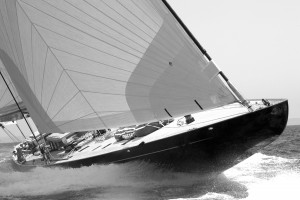
Rainbow launched. Cheveyo commissioned from Sparkman & Stephens / Spirit Yachts.

Information courtesy of the J Class Association
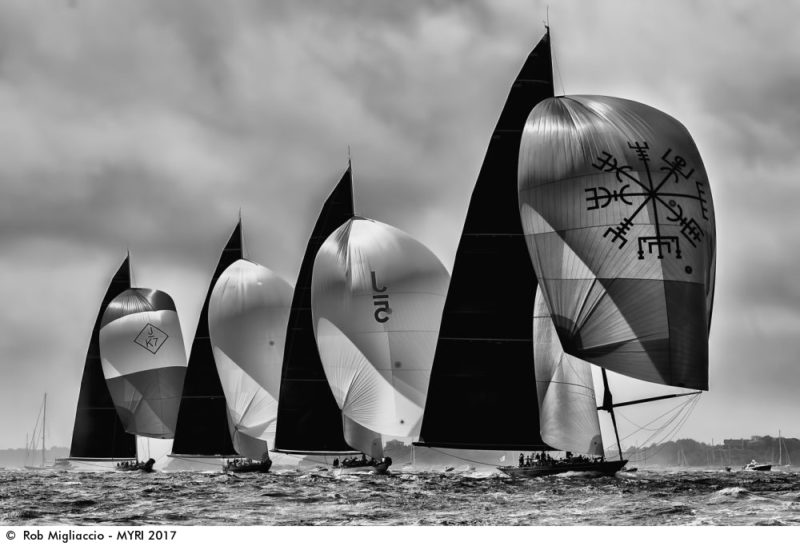
Svea, Velsheda and Topaz at the St Barths Bucket, 2018.
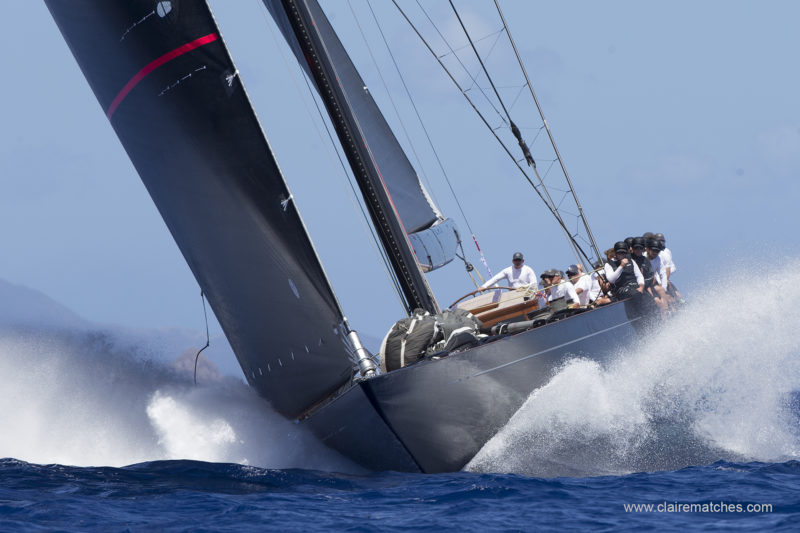
SHARE THIS:
- Yachts for Sale
Recently updated...
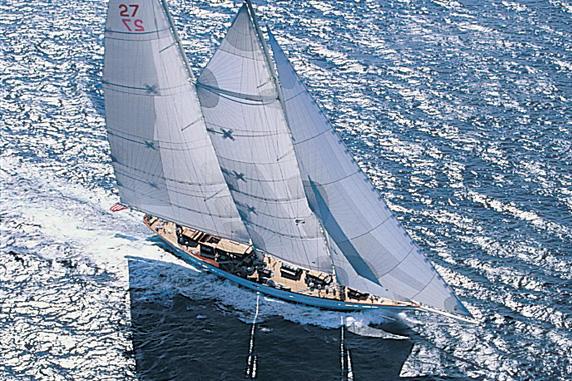
Write an Article
Covering news on classic yachting worldwide is a tall ask and with your input Classic Yacht Info can expose stories from your own back yard.
We are keen to hear about everything from local regattas and classic events to a local restoration or yachting adventure. Pictures are welcome and ideal for making the article more engaging.
With a site that has been created with the assistance of an international group of classic yacht enthusiasts we value your input and with your help we strive to make CYI more up-to-date and more informative than ever.
Please register and get in touch if you would like to contribute.

choose your language:
We’re passionate about Classic Yachts here at CYI, and we welcome submissions from all over the globe!
Captain, rigger, sail-maker or chef – if you’d like to write for CYI just let us know!
Email [email protected] to be set up as a Contributor, and share your Classic thoughts with the world.
ClassicYachtInfo.com has the largest database of classic yachts on the internet.
We’re continually working to keep it accurate and up-to-date, and we greatly appreciate contributions of any type. If you spot an error, or you have some information on a yacht and would like to contribute, please jump on in!
Don’t be shy…. Breeze on!
- Sell Your Yacht

Published on May 20th, 2024 | by Editor
J Class: The “Queen” is back
Published on May 20th, 2024 by Editor -->
The 1930s America’s Cup challenger Shamrock V – also known as “The Queen of the J Class” – was relaunched on May 20 at Saxon Wharf in Southampton, UK. This follows the most comprehensive restoration and rebuild in her 94-year history.
The 36.4-metre sailing yacht sustained significant structural damage and was laid up ashore while racing at the America’s Cup in 2017. Following a change of owner and a strip down “literally to the last bolt”, the sailing yacht has been restored to concurs condition after seven years.
The yacht hit the water at Camper & Nicholsons’ Gosport shipyard in 1930 as the first ever J Class, commissioned by Sir Thomas Lipton as his fifth and final challenge for the America’s Cup. She remains the only one built in wood and the only one to have never fallen into dereliction since her launch – the other two remaining members of the J Class fleet, the 38.5-metre Velsheda and the 39.6-metre Endeavour, had to be reconstructed entirely. – Full report

Tags: J Class , Shamrock
Related Posts
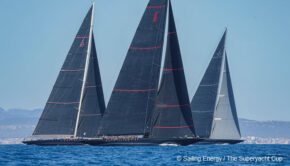
History returns to the America’s Cup →
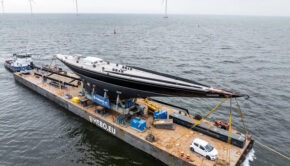
J Class: Making the commitment →
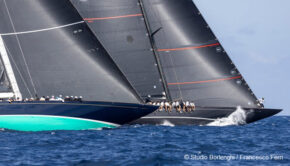
J Class to reunite with America’s Cup →
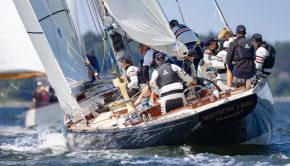
Life beyond the Auld Mug →
© 2024 Scuttlebutt Sailing News. Inbox Communications, Inc. All Rights Reserved. made by VSSL Agency .
- Privacy Statement
- Advertise With Us
Get Your Sailing News Fix!
Your download by email.
- Your Name...
- Your Email... *
- Phone This field is for validation purposes and should be left unchanged.

Yachting World

A stunning superyacht showdown in Palma

Superyacht Cup Palma: Fleet of Js set to race

The purist’s America’s Cup – the story of the seven-strong J Class Regatta in Bermuda

J Class picture highlights: spectacular images of 7 J Class sailing together at the 35th America’s Cup

A spectacular day as seven J Class yachts race for the first time ever
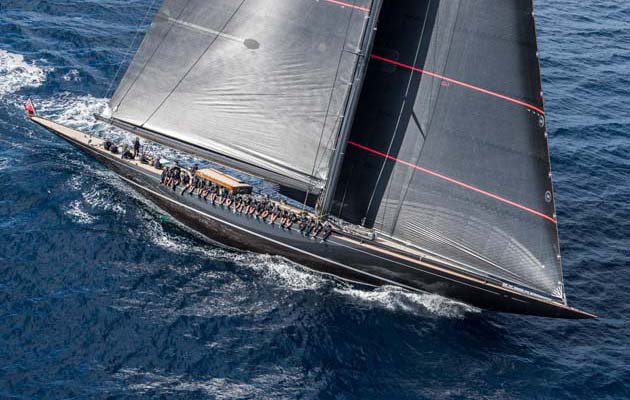

Inside J Class yacht Svea – what it’s really like to race on board the newest member of the fleet

Svea rules the day and Lionheart wins the J Class Superyacht Regatta in Bermuda
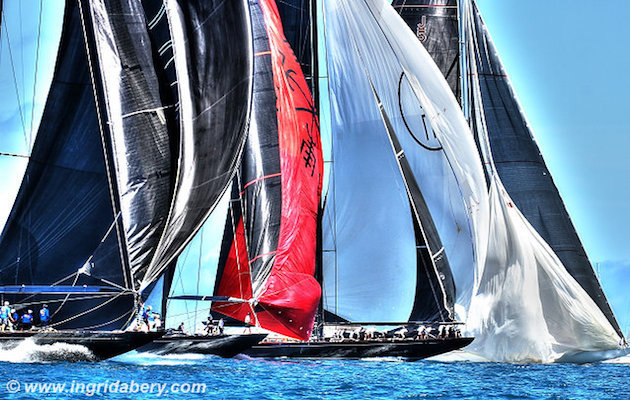
Brand new J S1 Svea stars in a record J Class racing fleet at America’s Cup
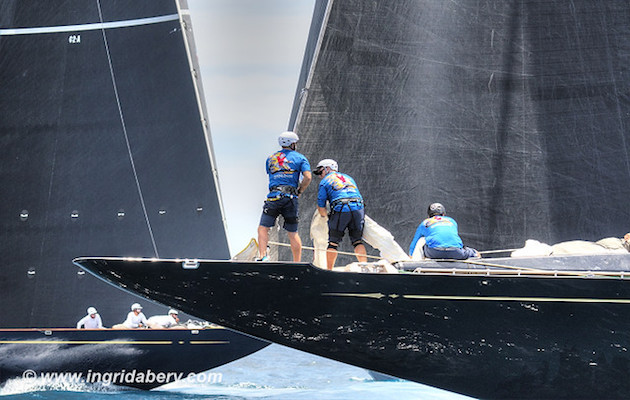
The J Class brings timeless elegance to the America’s Cup during their first day’s racing in Bermuda

Highlights and amazing images from St Barth as six J Class yachts race each other for the first time

The new heyday of the J Class – why this illustrious class is now more popular than ever
J class videos.

Video – a beautiful film of the J Class racing during the RYS Bicentenary regatta

Video: All the J Class action from Falmouth, as Velsheda, Ranger and Lionheart put on a show

Video – the timeless elegance of the J Class. Velsheda, Ranger and Lionheart dance on Falmouth waters
The 5 j’s battle it out in palma, 5 j-class race – video.

Videos: J Class Falmouth Regatta
J class pictures.

Three J Class yachts are racing in Falmouth – see the pictures and highlights from the first race here

J Class Regatta Solent

J Class Regatta Falmouth Day 3

J-Class UK regatta Falmouth Race 2

J Class Regatta Falmouth Race 1

J Class Regatta Falmouth Training
- Ranger History
- The New Ranger
- J Class Association
- Crew Profile
- Latest News
- Contact Details
J Class to hold 2024 World Championships in Barcelona in 2024

September 1, 2023
Image credit:
© Studio Borlenghi / Francesco Ferri.
No history of the America’s Cup is complete without mention of the J Class, the magnificent sloops that competed for the trophy in three editions between 1930 and 1937. Their grace and beauty reflected a time where a booming global economy brought some of the most colourful tycoons to compete for the oldest international sports trophy in the world. Names like Sir Thomas Lipton, Harold S Vanderbilt and Sir Thomas Sopwith graced a period that is known as the ‘Golden Age’ of the America’s Cup before the realities of the aftermath of the Second World War, saw the smaller, more affordable 12 Metre Class replace the J Class.
In modern times the J Class has thrived with owners either restoring or building new to old lines drawn but never constructed and to see one of the yachts in person is to witness sailing and racing at its very finest. With the America’s Cup in Barcelona in October 2024, the class have been welcomed by America’s Cup Events to host their World Championships between 7-11 th October 2024 with a practice regatta on the 3-4 th October 2024. The magnificent fleet have been allocated space in the Port Vell Harbour and will be a welcome sight for spectators and enthusiasts of the America’s Cup.
Speaking about the J Class coming to Barcelona, Grant Dalton, CEO of America’s Cup Events commented: “When the idea was first suggested, it was one of the easiest decisions ever to make. The J-Class are integral to the history, legend and fascination of the America’s Cup and we are very grateful to the Class Association and the Owners for taking the opportunity to host their World Championship in Barcelona at the time of the 37 th Match. Seeing those boats being raced just off the Barcelona waterfront will be a spectacle for everyone on the water or watching from the shoreline – we cannot wait to see them in action.”
The J Class fleet has grown in popularity in recent years and the fleet includes Topaz (J8), Ranger (J5), Svea (JS1), Velsheda (JK7), Shamrock V (JK3), Rainbow (JKZ1), Hanuman (JK6) and Lionheart (JH1). The Class Association is seeking a commitment from as many owners as possible with five confirmed to date and others working the America’s Cup into their busy global schedules.
Hosted by the Real Club Nàutic de Barcelona, situated right in the heart of the Port Vell, the club is looking forward to a fabulous J Class regatta in the city, with Jordi Puig, President of the Yacht Club saying: “T he opportunity to host the historic J Class for their World Championships in 2024 is something that myself and all the members of RCNB are immensely looking forward to. These yachts with their remarkable history both in the America’s Cup and into the modern era are one of the true wonders of the sailing world and will draw much attention when they arrive in Barcelona whilst acting as an integral part of the America’s Cup celebrations.”
Stuart Childerley, Class Secretary of the J Class, is delighted to be in the heart of the America’s Cup event in Barcelona 2024 saying: “ We are extremely grateful to Grant and his team for smoothing the passage to be included in the America’s Cup regatta where the DNA of our fleet essentially lies, and we look forward to playing a central part in the programme both on and off the water. The Owners and Class Association are excited to hold our World Championships in Barcelona which will be the highlight of our season after the Maxi Worlds in Porto Cervo during September 2024 and the Mahon regatta in May 2024. The boats will arrive to the Port Vell and be situated right in the heart of the superyacht basin giving spectators a fantastic opportunity to see these historic yachts up close.”
Details of the 2024 World Championships in Barcelona will shortly be available on the J-Class Association website www.jclassyachts.com and circulated to Owners and Owner’s Representatives in due course.

This site uses cookies to enhance your experience. By continuing to browse the site, you consent to the use of cookies. View our Privacy Policy for more information.
Livny Weather Forecast
Air temperature,
Average wind speed,
Wind gusts,
Wind direction
Birch pollen, points
Grass pollen, points
Ragweed pollen, points
Precipitation in liquid equivalent, mm
Falling snow, cm
Snow depth, cm
Relative humidity, %
UV Index, points
G/m activity, Kp-index

IMAGES
VIDEO
COMMENTS
J Class yachts Velsheda, Topaz and Svea downwind legs. The J Class is one of several classes deriving from the Universal Rule for racing boats. The rule was established in 1903 and rates double-masted racers (classes A through H) and single-masted racers (classes I through S). From 1914 to 1937, the rule was used to determine eligibility for ...
Learn about the history, yachts and events of the J Class, a class of magnificent sailboats that competed for the America's Cup in the 1930s. Find out how they were revived and how to follow their modern-day races around the world.
Learn about the history, design and performance of the J Class yachts, the classic sailing boats that compete in the most prestigious regattas. Compare the features, specifications and predictions of the nine J Class yachts, from the original wooden Shamrock to the modern carbon Hanuman.
Learn about the history, design and racing of the J Class, a legendary class of 130ft sloops that emerged in 1930 and made a comeback in the last 20 years. Discover why these magnificent yachts are irresistible to captains of industry and enthusiasts of elegance.
Ranger is a 41.55 metre replica of the J Class yacht of the same name, which was built for the 1937 America's Cup by a syndicate led by railroad heir Harold Vanderbilt. Starling Burgess and Olin Stephens had been asked to produce eight sets of lines and the one selected as most suitable for the conditions expected off Newport, Rhode Island — design number 77C — was one of Burgess ...
Yachts. In total nine J Class yachts are currently active, including three original surviving Js - Velsheda, Shamrock and Endeavour - and six replicas that have been built since 2003; Ranger, Rainbow, Hanuman, Lionheart, Topaz and Svea.
Think of classic J Class pictures from the 1930s and you picture a helmsman in a blazer and tie standing high on the aft deck battling a traditional wooden wheel.
In total nine J Class yachts are active now with six replicas having been built since 2003; Ranger, Rainbow, Hanuman, Lionheart, Topaz and Svea. The J Class Association (JCA) was founded to protect the interests of the Class, present and future. Among its responsibilities it monitors and agrees the veracity of designs to which new replica boats ...
The tide turned fair again for the J Class only as recently as 1984, when American sailor Elizabeth Meyer bought the hulk of Endeavour and set about restoring her. "Elizabeth is very much the catalyst for the revival of the J Class with the renovation of Endeavour in 1984," Philip Lotz, commodore of the New York Yacht Club, said in 2017. "Her vision and inspiration… got restoration ...
Before the J Class yachts came into existence, yachts were designed to be bigger and bigger. The towering rigs of the Big Boat Class such as 'Lulworth' and 'Britannia' dwarfed all other yachts. The late 1920s heralded discussion and agreement of the Universal Rule. This new formula controlled the size and displacement of the new […]
J Class Yachts. Go inside the world of the iconic J Class yachts with reports on board these famous vessels, interviews with their owners and coverage of the J Class World Championships. Boat International is the official media partner of the J Class Association.
The J/70 Speedster (22.75 feet) is J/Boats' first ramp-launchable, keelboat - designed to fulfill the need for an easy-to-own, high performance one-design that's exciting to sail, stable enough for the entire family, AND easy to tow, rig, launch and sail. Since its introduction in 2012, the J/70 has become the most prolific sportboat in the ...
Measuring 43.4 meters (142 feet), Lionheart is the longest J Class in existence. She also has astounding 17-meter (56-foot) overhangs. She's built entirely of aluminum, something the new J Class rules permits (the original Js were made of steel). Her builder, Claasen Jachtbouw, had a good working relationship with Hoek, having constructed 16 ...
Svea is the newest J Class yacht in the current fleet and was launched in January 2017. At 143ft/43.6m Svea has the longest LOA by 15cms. Her original designs were drawn in 1937 by Swedish Olympian and renowned 6 and 8 Metre boat designer Tore Holm along with compatriot boatbuilder Gustav Plym, but war put paid to any hopes of a Swedish America's Cup challenge.
Published on May 20th, 2024. The 1930s America's Cup challenger Shamrock V - also known as "The Queen of the J Class" - was relaunched on May 20 at Saxon Wharf in Southampton, UK. This ...
Recognized as an international class by World Sailing, the J/24 has been selected for use in nearly every major international championship, including the PanAm Games, World Sailing Games, and Nations Cup. The J/24 is the world's most popular keelboat class, with over 5,500 boats built and over 50,000 people actively sailing in more than 150 ...
Discover J Class yachts with Yachting World. From race results to yacht profiles and videos, we have the definitive guide to the 2015 J class calender.
Ranger is the first J Class yacht to be built since their heyday in the 1930s, and truly she is a thing of beauty.
Postal code (s) [6] 303850. OKTMO ID. 54705000001. Livny ( Russian: Ливны) is a town in Oryol Oblast, Russia. As of 2018, it had a population of 47,221.
Points of Interest & Landmarks • Architectural Buildings. 27. Monument to V. I. Lenin. Points of Interest & Landmarks • Monuments & Statues. 28. Sculpture of a Woman with a Satellite in Hand. Monuments & Statues. 29. Memorial Sign in Honor of the 400th Anniversary of the City of Livny.
The Owners and Class Association are excited to hold our World Championships in Barcelona which will be the highlight of our season after the Maxi Worlds in Porto Cervo during September 2024 and the Mahon regatta in May 2024. The boats will arrive to the Port Vell and be situated right in the heart of the superyacht basin giving spectators a ...
Отделы судебных приставов Ливен - полный список, официальные сайты, телефоны, режим (график) работы, отзывы.
Livny Weather Forecast for Today. Now. 16:31